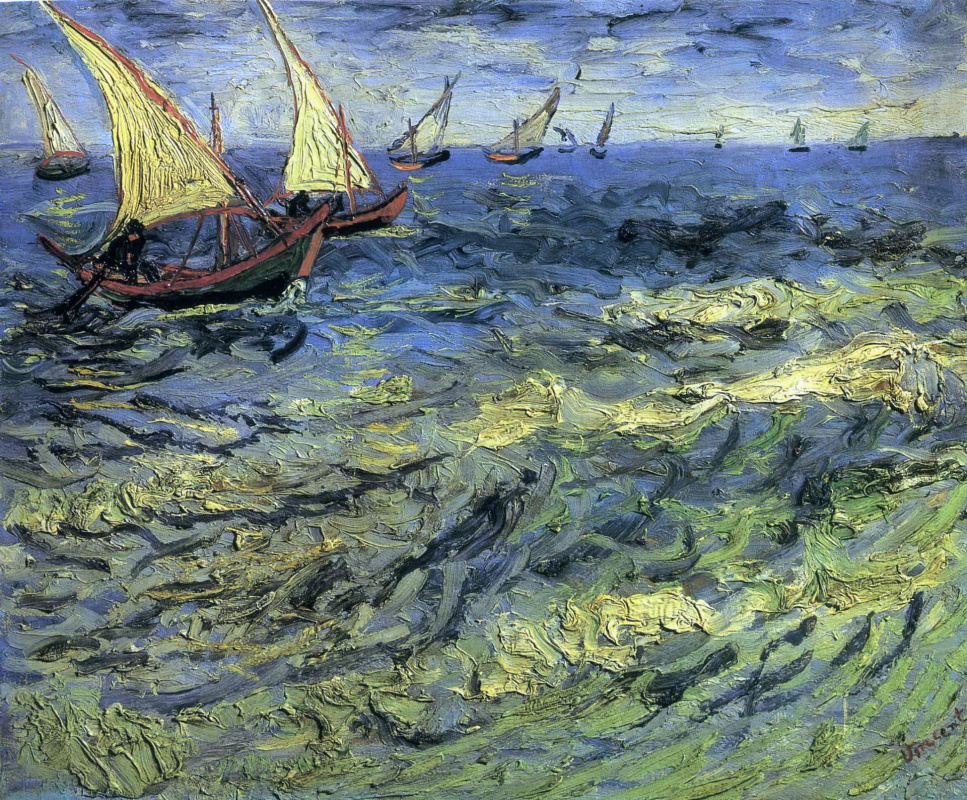log in
Enter site
Login to use Arthive functionality to the maximum
Seascape at Saintes-Maries (Fishing Boats at Sea)
Vincent van Gogh • Painting, June 1888, 44.5×54.5 cm
Description of the artwork «Seascape at Saintes-Maries (Fishing Boats at Sea)»
In the summer of 1888, Vincent Van Gogh lived in the south of France, in Arles, where he created his most famous paintings. In June, the artist decided to go to the sea - in the small fishing village of Saintes-Maries-de-la-Mer.
Vincent hoped that the sea air would improve his poor health, which worsened every year due to malnutrition and excessive consumption of alcoholic beverages. On a weeklong trip, van Gogh took with him three canvases and several sheets of paper. The painting Seascape at Saintes-Maries became one of the two seascapes painted by the artist during this "vacation". On the third canvas, Vincent painted white cottages.
In Sainte-Marie-de-La-Mer, the artist was particularly impressed by the Mediterranean Sea. It was nothing like the unfriendly and gloomy North Sea, which the artist painted in Scheveningen. In one of the letters to Theo, van Gogh wrote, "The Mediterranean – has a color like mackerel, in other words, changing – you don’t always know if it’s green or purple – you don’t always know if it’s blue – because a second later, its changing reflection has taken on a pink or grey hue." In this respect, one can say that Seascape at Saintes-Maries is one of Vincent's most impressionistic works, as he spent quite a lot of time "catching" and displaying the right light.
Moreover, this picture helped the researchers of Van Gogh's art better understand the artist's painting technique. According to experts from the Van Gogh Museum in Amsterdam, on this canvas there were grains of sand trapped in the paint. This led to the conclusion that Vincent applied a layer of paint to the canvas, then sand blew over it, and then the artist added another layer of paint before the first layer had time to dry. The grains were spread by brush across the entire surface of the canvas, leaving traces in the paint. Later Vincent finished this painting in his studio in Arles.
Apparently, this short trip brought Van Gogh peace of mind. In another letter to his brother, the artist wrote: "One night I went for a walk by the sea along the empty shore. It was not gay, but neither was it sad - it was - beautiful. The deep blue sky was flecked with clouds of a blue deeper than the fundamental blue of intense cobalt, and others of a clearer blue, like the blue whiteness of the Milky Way. In the blue depth, the stars were sparkling, greenish, yellow, white, pink, more brilliant, more emeralds, lapis lazuli, rubies, sapphires. The sea was very deep ultramarine - the shore a sort of violet and faint russet."
Vincent hoped that the sea air would improve his poor health, which worsened every year due to malnutrition and excessive consumption of alcoholic beverages. On a weeklong trip, van Gogh took with him three canvases and several sheets of paper. The painting Seascape at Saintes-Maries became one of the two seascapes painted by the artist during this "vacation". On the third canvas, Vincent painted white cottages.
In Sainte-Marie-de-La-Mer, the artist was particularly impressed by the Mediterranean Sea. It was nothing like the unfriendly and gloomy North Sea, which the artist painted in Scheveningen. In one of the letters to Theo, van Gogh wrote, "The Mediterranean – has a color like mackerel, in other words, changing – you don’t always know if it’s green or purple – you don’t always know if it’s blue – because a second later, its changing reflection has taken on a pink or grey hue." In this respect, one can say that Seascape at Saintes-Maries is one of Vincent's most impressionistic works, as he spent quite a lot of time "catching" and displaying the right light.
Moreover, this picture helped the researchers of Van Gogh's art better understand the artist's painting technique. According to experts from the Van Gogh Museum in Amsterdam, on this canvas there were grains of sand trapped in the paint. This led to the conclusion that Vincent applied a layer of paint to the canvas, then sand blew over it, and then the artist added another layer of paint before the first layer had time to dry. The grains were spread by brush across the entire surface of the canvas, leaving traces in the paint. Later Vincent finished this painting in his studio in Arles.
Apparently, this short trip brought Van Gogh peace of mind. In another letter to his brother, the artist wrote: "One night I went for a walk by the sea along the empty shore. It was not gay, but neither was it sad - it was - beautiful. The deep blue sky was flecked with clouds of a blue deeper than the fundamental blue of intense cobalt, and others of a clearer blue, like the blue whiteness of the Milky Way. In the blue depth, the stars were sparkling, greenish, yellow, white, pink, more brilliant, more emeralds, lapis lazuli, rubies, sapphires. The sea was very deep ultramarine - the shore a sort of violet and faint russet."



